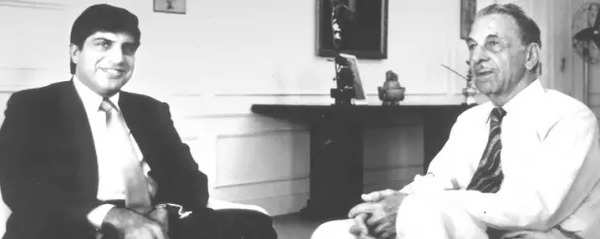Ratan Naval Tata, a titan of industry who never sought the spotlight, passed away on Wednesday night at a Mumbai hospital at the age of 86. Despite his immense influence and control over more than 30 companies operating in over 100 countries across six continents, Ratan Tata lived a modest life and never appeared on any list of billionaires.
Ratan Tata joined the family firm after acquiring a B.S.in architecture from Cornell University, Ithaca, New York, in 1962. He started his career by working on the shop floor, acquiring hands-on experience across different Tata Group businesses.
In 1971, he was appointed director-in-charge of National Radio and Electronics Co. (Nelco), one of the group’s companies.
He became chairman of Tata Industries a decade later and in 1991, took over as the chairman of the Tata Group from his uncle, JRD, who had been in charge for more than half a century.

Ratan Tata with JRD Tata (Image source: Tata.com)
Tata’s ascension to the role of chairman coincided with India’s economic liberalization in 1991. Under his leadership, the Tata Group, which had humble beginnings as a small textile and trading firm in 1868, transformed into a global powerhouse with diverse operations ranging from salt and steel to cars, software, power plants, and airlines.
Ratan Tata led Tata Sons for over two decades, during which the group pursued aggressive expansion.
Also Read | A legacy to remember: Top 20 quotes by Ratan Tata
Under his leadership, Tata Sons acquired several high-profile companies, including Tetley Tea for $431.3 million in 2000, Daewoo Motors’ truck-manufacturing operations for $102 million in 2004, Corus Group for $11.3 billion, and Jaguar and Land Rover from Ford Motor Company for $2.3 billion.
In December 2012, he handed over control of Tata Sons to his then-deputy, Cyrus Mistry. However, disagreements arose over Mistry’s leadership, leading to his removal in October 2016, marking the end of the first non-Tata family member’s tenure as chairman.
Ratan Tata was among the shareholders who disagreed with Mistry on various projects, including the decision to discontinue the loss-making small car, Nano, which was a pet project of Ratan Tata.
Following Mistry’s removal, Tata took on the role of interim chairman from October 2016 until January 2017, when Natarajan Chandrasekaran was appointed as the new chairman of the Tata Group.
Since then, Ratan Tata has been serving as the emeritus chairman of Tata Sons.
Also Read | Ratan Tata, the industry titan, with a golden heart
In recent years, Ratan Tata has taken on a new role, supporting young entrepreneurs and investing in tech-driven start-ups that have the potential to shape the future of the country.
Through his personal investments and his investment company, RNT Capital Advisors, Tata has invested in more than 30 start-ups, including Ola Electric, Paytm, Snapdeal, Lenskart, and Zivame.
- 1955: At the age of 17, he departs for Cornell University in Ithaca, New York, to pursue studies in architecture and engineering.
- 1962: Graduates with a Bachelor of Architecture degree.
- 1962: Joins Tata Group as an assistant in Tata Industries; undergoes six months of training at Tata Engineering and Locomotive Company (now
Tata Motors ) in Jamshedpur. - 1963: Participates in a training program at Tata Iron and Steel Company (now Tata Steel) in Jamshedpur.
- 1965: Appointed as a technical officer in Tisco’s engineering division.
- 1969: Serves as the Tata Group’s resident representative in Australia.
- 1970: Returns to India and briefly joins Tata Consultancy Services (TCS), a fledgling software company at the time.
- 1971: Becomes director-in-charge of National Radio and Electronics (Nelco), an ailing electronics firm.
- 1974: Joins the board of Tata Sons as a director.
- 1975: Completes the Advanced Management Program at Harvard Business School.
- 1981: Appointed Chairman of Tata Industries and initiates its transformation into a promoter of high-tech businesses.
- 1983: Develops the Tata strategic plan.
- 1986-1989: Serves as Chairman of Air India.
- March 25, 1991: Succeeds JRD Tata as Chairman of Tata Sons and Tata Trusts.
- 1991: Begins restructuring the Tata Group amid India’s economic liberalisation.
- 2000 onwards: Leads Tata Group’s growth and globalisation, with notable acquisitions like Tetley, Corus,
Jaguar Land Rover , Brunner Mond, General Chemical Industrial Products, and Daewoo. - 2008: Launches the Tata Nano, a small car project driven by his vision and leadership.
- December 2012: Steps down as Chairman of Tata Sons after 50 years with the group and is named Chairman Emeritus.


